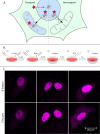Examining transfer of TERT to mitochondria under oxidative stress
- PMID: 39406807
- PMCID: PMC11480324
- DOI: 10.1038/s41598-024-75127-4
Examining transfer of TERT to mitochondria under oxidative stress
Abstract
The primary role of telomerase is the lengthening of telomeres. Nonetheless, emerging evidence highlights additional functions of telomerase outside of the nucleus. Specifically, its catalytic subunit, TERT (Telomerase Reverse Transcriptase), is detected in the cytosol and mitochondria. Several studies have suggested an elevation in TERT concentration within mitochondria in response to oxidative stress. However, the origin of this mitochondrial TERT, whether transported from the nucleus or synthesized de novo, remains uncertain. In this study, we investigate the redistribution of TERT, labeled with a SNAP-tag, in response to oxidative stress using laser scanning fluorescence microscopy. Our findings reveal that, under our experimental conditions, there is no discernible transport of TERT from the nucleus to the mitochondria due to oxidative stress.
Keywords: Mitochondria; Oxidative stress; Protein transport; SNAP-tag; TERT.
© 2024. The Author(s).
Conflict of interest statement
The authors declare no competing interests.
Figures




References
MeSH terms
Substances
Grants and funding
- FSMG-2024-0012, agreement 075-03-2024-117/Ministry of Science and Higher Education of the Russian Federation
- FSMG-2024-0012, agreement 075-03-2024-117/Ministry of Science and Higher Education of the Russian Federation
- FSMG-2024-0012, agreement 075-03-2024-117/Ministry of Science and Higher Education of the Russian Federation
- FSMG-2023-0015, agreement 075-03-2023-106/Ministry of Science and Higher Education of the Russian Federation
- FSMG-2024-0012, agreement 075-03-2024-117/Ministry of Science and Higher Education of the Russian Federation
- FSMG-2024-0012, agreement 075-03-2024-117/Ministry of Science and Higher Education of the Russian Federation
- FSMG-2023-0015, agreement 075-03-2023-106/Ministry of Science and Higher Education of the Russian Federation
- FSMG-2024-0012, agreement 075-03-2024-117/Ministry of Science and Higher Education of the Russian Federation
- 22-74-10036/Russian Science Foundation
LinkOut - more resources
Full Text Sources

